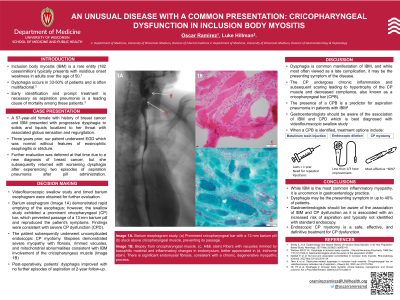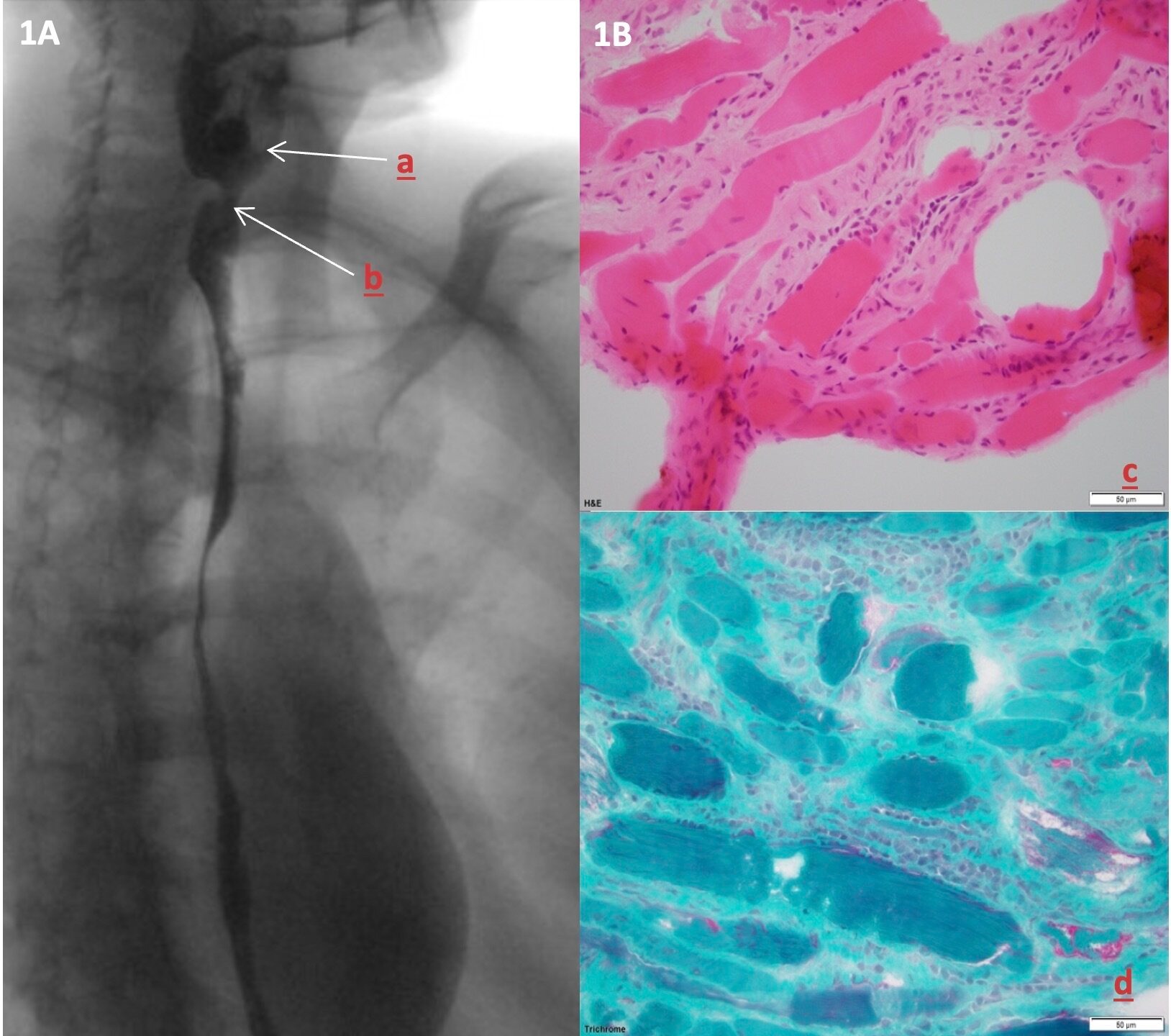Monday Poster Session
Category: Esophagus
P1860 - An Unusual Disease With a Common Presentation: Cricopharyngeal Dysfunction in Inclusion Body Myositis
Monday, October 23, 2023
10:30 AM - 4:15 PM PT
Location: Exhibit Hall

Has Audio

Oscar Ramirez Ramirez, MD
University of Wisconsin
Madison, WI
Presenting Author(s)
Oscar Ramirez Ramirez, MD, Luke Hillman, MD
University of Wisconsin, Madison, WI
Introduction: Inclusion body myositis (IBM) is seen in adults over the age of 50. Cricopharyngeal dysfunction is a frequent cause of dysphagia among patients with inclusion body myositis (IBM). Early identification and prompt treatment is necessary as aspiration pneumonia is a leading cause of mortality among these patients. Gastroenterologists should be aware of this entity in the elderly population, as early therapies can be offered to manage symptoms and prevent complications.
Case Description/Methods: A 57-year-old female with history of breast cancer and IBM presented with progressive dysphagia to solids and liquids localized to her throat with associated globus sensation and regurgitation. Three years prior, our patient underwent esophagogastroduodenoscopy which was normal without features of eosinophilic esophagitis or stricture. Further evaluation was deferred at that time due to a new diagnosis of breast cancer, but she subsequently returned with worsening dysphagia after experiencing two episodes of aspiration pneumonia after pill administration.
Videoflouroscopic swallow study and timed barium esophagram were obtained for further evaluation. Barium esophagram (Image 1A) demonstrated rapid emptying of the esophagus; however, the swallow study exhibited a prominent cricopharyngeal (CP) bar, which prevented passage of a 13 mm barium pill and reproduced the patient’s symptoms. Findings were consistent with severe CP dysfunction (CPD).
The patient subsequently underwent uncomplicated endoscopic CP myotomy. Biopsies demonstrated severe myopathy with fibrosis, rimmed vacuoles, and mitochondrial abnormalities consistent with IBM involvement of the cricopharyngeus muscle (Image 1B). Post-operatively, the patient’s dysphagia markedly improved with increased ease of taking pills.
Discussion:
While IBM is the most common inflammatory myopathy, it is uncommon in gastroenterology practice. IBM is characterized by insidious onset of progressive weakness in proximal legs and finger flexors. While our patient already had a diagnosis of IBM, dysphagia may be the presenting symptom in up to 40% of patients. Gastroenterologists should be aware of the association of IBM and CP dysfunction as CP bars are associated with an increased risk of aspiration, one of the leading causes of death, and are often not identified with standard endoscopy. Endoscopic CP myotomy is a safe, effective, and definitive treatment for CP dysfunction.

Disclosures:
Oscar Ramirez Ramirez, MD, Luke Hillman, MD. P1860 - An Unusual Disease With a Common Presentation: Cricopharyngeal Dysfunction in Inclusion Body Myositis, ACG 2023 Annual Scientific Meeting Abstracts. Vancouver, BC, Canada: American College of Gastroenterology.
University of Wisconsin, Madison, WI
Introduction: Inclusion body myositis (IBM) is seen in adults over the age of 50. Cricopharyngeal dysfunction is a frequent cause of dysphagia among patients with inclusion body myositis (IBM). Early identification and prompt treatment is necessary as aspiration pneumonia is a leading cause of mortality among these patients. Gastroenterologists should be aware of this entity in the elderly population, as early therapies can be offered to manage symptoms and prevent complications.
Case Description/Methods: A 57-year-old female with history of breast cancer and IBM presented with progressive dysphagia to solids and liquids localized to her throat with associated globus sensation and regurgitation. Three years prior, our patient underwent esophagogastroduodenoscopy which was normal without features of eosinophilic esophagitis or stricture. Further evaluation was deferred at that time due to a new diagnosis of breast cancer, but she subsequently returned with worsening dysphagia after experiencing two episodes of aspiration pneumonia after pill administration.
Videoflouroscopic swallow study and timed barium esophagram were obtained for further evaluation. Barium esophagram (Image 1A) demonstrated rapid emptying of the esophagus; however, the swallow study exhibited a prominent cricopharyngeal (CP) bar, which prevented passage of a 13 mm barium pill and reproduced the patient’s symptoms. Findings were consistent with severe CP dysfunction (CPD).
The patient subsequently underwent uncomplicated endoscopic CP myotomy. Biopsies demonstrated severe myopathy with fibrosis, rimmed vacuoles, and mitochondrial abnormalities consistent with IBM involvement of the cricopharyngeus muscle (Image 1B). Post-operatively, the patient’s dysphagia markedly improved with increased ease of taking pills.
Discussion:
While IBM is the most common inflammatory myopathy, it is uncommon in gastroenterology practice. IBM is characterized by insidious onset of progressive weakness in proximal legs and finger flexors. While our patient already had a diagnosis of IBM, dysphagia may be the presenting symptom in up to 40% of patients. Gastroenterologists should be aware of the association of IBM and CP dysfunction as CP bars are associated with an increased risk of aspiration, one of the leading causes of death, and are often not identified with standard endoscopy. Endoscopic CP myotomy is a safe, effective, and definitive treatment for CP dysfunction.

Figure: Image 1A. Barium esophagram study. (a) Prominent cricopharyngeal bar with a 13 mm barium pill (b) stuck above cricopharyngeal muscle, preventing its passage.
Image 1B. Biopsy from cricopharyngeal muscle. (c, H&E stain) Fibers with vacuoles rimmed by basophilic material and inflammatory changes in endomysium, better appreciated in (d, trichome stain). There is significant endomysial fibrosis, consistent with a chronic, degenerative myopathic process.
Image 1B. Biopsy from cricopharyngeal muscle. (c, H&E stain) Fibers with vacuoles rimmed by basophilic material and inflammatory changes in endomysium, better appreciated in (d, trichome stain). There is significant endomysial fibrosis, consistent with a chronic, degenerative myopathic process.
Disclosures:
Oscar Ramirez Ramirez indicated no relevant financial relationships.
Luke Hillman indicated no relevant financial relationships.
Oscar Ramirez Ramirez, MD, Luke Hillman, MD. P1860 - An Unusual Disease With a Common Presentation: Cricopharyngeal Dysfunction in Inclusion Body Myositis, ACG 2023 Annual Scientific Meeting Abstracts. Vancouver, BC, Canada: American College of Gastroenterology.
